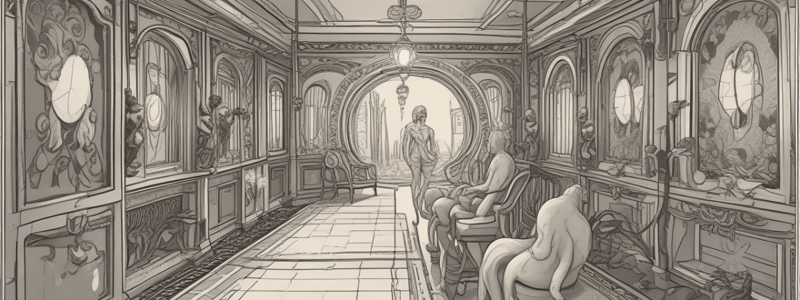Podcast
Questions and Answers
What is the condition under which the Rescorla-Wagner (R-W) model assumes learning will take place?
What is the condition under which the Rescorla-Wagner (R-W) model assumes learning will take place?
- During the extinction phase
- When the associative strength of the CS is high
- When the US is surprising (correct)
- When the US is unsurprising
What is the phenomenon where pre-training with one CS blocks learning about a second CS?
What is the phenomenon where pre-training with one CS blocks learning about a second CS?
- Overshadowing
- Latent inhibition
- Blocking (correct)
- Sensitization
What is the term for the process by which a stimulus competes with another stimulus for associative strength?
What is the term for the process by which a stimulus competes with another stimulus for associative strength?
- Stimulus interference
- Stimulus competition (correct)
- Stimulus enhancement
- Stimulus facilitation
What is the outcome of the test for CS2 in the blocking paradigm?
What is the outcome of the test for CS2 in the blocking paradigm?
What is the effect of increasing the intensity or salience of a stimulus on associative strength?
What is the effect of increasing the intensity or salience of a stimulus on associative strength?
What is the primary reason why the Rescorla-Wagner model fails to predict latent inhibition?
What is the primary reason why the Rescorla-Wagner model fails to predict latent inhibition?
What happens to the conditioned response when there is pre-exposure to the to-be-CS?
What happens to the conditioned response when there is pre-exposure to the to-be-CS?
According to the Sometimes Opponent Process model, what is the relationship between the CS and the US during the pre-exposure phase?
According to the Sometimes Opponent Process model, what is the relationship between the CS and the US during the pre-exposure phase?
What is the mathematical expression for the change in the associative value of the CS during the pre-exposure phase?
What is the mathematical expression for the change in the associative value of the CS during the pre-exposure phase?
What is the primary function of the pre-exposure phase in latent inhibition?
What is the primary function of the pre-exposure phase in latent inhibition?
What is a key limitation of the R-W model in terms of extinction?
What is a key limitation of the R-W model in terms of extinction?
What is the primary explanation for the phenomenon of spontaneous recovery?
What is the primary explanation for the phenomenon of spontaneous recovery?
What is the term for the process by which the response to an absent cue is changed by changing the status of a companion cue?
What is the term for the process by which the response to an absent cue is changed by changing the status of a companion cue?
What is the phenomenon in which a surprising downshift in reward enhances attention to a light cue?
What is the phenomenon in which a surprising downshift in reward enhances attention to a light cue?
What is the term for the process by which a sensory cue results in conditioning to the tone?
What is the term for the process by which a sensory cue results in conditioning to the tone?
What is the key characteristic of a conditioned inhibitor?
What is the key characteristic of a conditioned inhibitor?
Study Notes
Latent Inhibition
- Pre-exposure to the to-be-conditioned stimulus (CS) impairs conditioning, as shown by Lubow (1965)
- Control group: 80% leg flexion in response to the CS, whereas the pre-exposure group showed only 30% leg flexion
Rescorla-Wagner Model
- The model fails to predict latent inhibition, which occurs when the CS is presented without the unconditioned stimulus (US) during the pre-exposure phase
- During the pre-exposure phase, λ = 0 (no US is presented), and ΔVi = α (λ - Vi-1)
- During the conditioning phase, λ = 1 (US is present), and ΔVi = α (1 - Vi-1)
Accounting for Latent Inhibition
- Wagner's 'Sometimes Opponent Process' model can account for latent inhibition
- According to this model, Vtotal = Vtone + Vlight, where Vtotal determines the level of surprise and subsequent association with the US
- Low Vtotal makes the US surprising, whereas high Vtotal makes the US unsurprising
Blocking
- Pre-training with one CS can block learning about a second CS, presented in a compound training session
- R-W model correctly predicts that stimuli compete for predictive value and higher associative strength (V) accrues to the higher-intensity (or salience) stimulus
- Example: Phase 1 - CS1 → US, followed by CS1 + CS2 → US, and CS2 test shows impaired learning for CS2
Limitations of the Rescorla-Wagner Model
- R-W model assumes that learning occurs only when the US is surprising
- R-W model fails to account for spontaneous recovery after extinction
- R-W model also fails to account for facilitated reacquisition after extinction
- Extinction ≠ 'unlearning', and R-W model cannot explain this phenomenon
Studying That Suits You
Use AI to generate personalized quizzes and flashcards to suit your learning preferences.
Related Documents
Description
This quiz explores the phenomenon of latent inhibition, where pre-exposure to a stimulus impairs classical conditioning. Understand the Rescorla-Wagner model and how it fails to predict latent inhibition. Learn about the role of pre-exposure and conditioning phases in classical conditioning.




